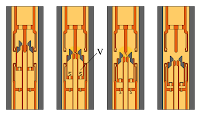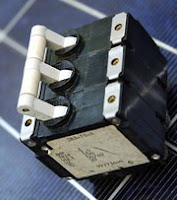Distribution boards are also known as:-
- breaker panel
- fuse box
- circuit breaker panel
- consumer unit, or CU
- panelboard
- load center
Fuseboxes & CUs
Domestic CUs in Britain usually fall into 2 categories:
- Modern CU with mcbs & RCD
- Older fusebox, usually containing no RCD.
Domestic fuseboxes/CUs normally have the breakers or fuses arranged in a single horizontal row. Twin vertical row boxes are seen in commercial premises where a greater number of ways is required.
Modern CU
A typical new domestic CU used as a main panel may have anything from 6 to 12 ways for mcbs. Secondary CUs used for outbuildings usually have 1 or 2 ways. Most CUs have one RCD built in, but not all. These boxes are frequently white or grey. Split CUs are now popular in new installs. Commercial CUs are larger with more ways.
New British distribution boards generally have the live parts enclosed to IP20, even when the cover has been removed for servicing.
Older fusebox
Older fuseboxes usually use rewirable fuses with no other protective device, and basic 4 ways boxes are very common. A lot of these boxes are made of brown-black bakelite, sometimes with a wooden base. Although their design is historic, these were standard equipment for new installs as recently as the 1980s, so are very common.
Users should be wary of these fuseboxes, as typically pulling a fuse carrier out with the power on results in fingers grasping live connections, and these boxes are widespread even in modern installations.
The popular 4 way fusebox usually has 2 lighting and 2 socket circuits, with heavy or sustained loads such as immersion heater and oven on a socket circuit. This arrangement is not recommended practice today, but it is common in existing installations. Larger boxes with more ways will have separate fuses for large loads such as immersion heater, oven and shower.
MCB Retrofits
Some of these fuseboxes have had their fuse carriers relaced with plug in MCBs. These retrofit mcbs are typically rated at 3kA breaking capacity, but many properties have PSCCs as high as 6kA. Hence these mcbs do not have sufficient breaking capacity for safe reliable operation in many premises.
Historic Fuseboxes
There is also a small number of pre-1950 fuseboxes still in service. Where encountered these should be treated with caution. Bare live parts are common on these boxes, and the installations they supply are frequently not EEBAD.
Pre-1950 installations in the UK should be retired from service, as UK wiring of this age is in most cases dangerously deteriorated, as well as lacking basic safety fatures. This contrasts with historic American systems, which are frequently still in serviceable condition.
Split CUs
A split CU is one CU divided electrically into 2 halves, each of which is switched independantly. These are popular in new installs in the UK. They allow power to remain on whille work is carried out, and usually one main switch is replaced by an RCD, giving both RCD and non-RCD circuits.
 Mobile operation
Mobile operation
Sometimes it is desired to have a portable breaker panel, for example, for special events. In this case, a breaker panel is mounted to a board, together with various sockets. These are common in the movie industry. The American one pictured at the right has a cord with an L21-30 plug to supply power. Power leaves the board through four three-phase circuits: three 15 ampere circuits; and one 20 A circuit. The 15 A circuits each go to a triplex-box. The 20 A circuit goes to an L21-20 receptacle, and one leg of it goes to a 20 A duplex receptacle shown at the upper left. The neon nightlights on the upper right triplex box are to show the phase sequence.

 The achievement around 1983 of the first single-break 245 kV and the corresponding 420kV to 550 kV and 800 kV, with respectively 2, 3, and 4 chambers per pole, lead to the dominance of SF6 circuit breakers in the complete range of high voltages.
The achievement around 1983 of the first single-break 245 kV and the corresponding 420kV to 550 kV and 800 kV, with respectively 2, 3, and 4 chambers per pole, lead to the dominance of SF6 circuit breakers in the complete range of high voltages. The reduction of operating energy was mainly achieved by the lowering energy used for gas compression and by making increased use of arc energy to produce the pressure necessary to quench the arc and obtain current interruption. Low current interruption, up to about 30% of rated short-circuit current, is obtained by a puffer blast.
The reduction of operating energy was mainly achieved by the lowering energy used for gas compression and by making increased use of arc energy to produce the pressure necessary to quench the arc and obtain current interruption. Low current interruption, up to about 30% of rated short-circuit current, is obtained by a puffer blast. This technique, known as “self-blast” has now been used extensively since 1996 for the development of many types of interrupting chambers. The increased understanding of arc interruption obtained by digital simulations and validation through breaking tests, contribute to a higher reliability of these self-blast circuit breakers. In addition the reduction in operating energy, allowed by the self blast technique, leads to longer service life.
This technique, known as “self-blast” has now been used extensively since 1996 for the development of many types of interrupting chambers. The increased understanding of arc interruption obtained by digital simulations and validation through breaking tests, contribute to a higher reliability of these self-blast circuit breakers. In addition the reduction in operating energy, allowed by the self blast technique, leads to longer service life. The thermal and self blast principles have enabled the use of low energy spring mechanisms for the operation of high voltage circuit breakers. They progressively replaced the puffer technique in the 1980s; first in 72.5 kV breakers, and then from 145 kV to 800 kV.
The thermal and self blast principles have enabled the use of low energy spring mechanisms for the operation of high voltage circuit breakers. They progressively replaced the puffer technique in the 1980s; first in 72.5 kV breakers, and then from 145 kV to 800 kV.









